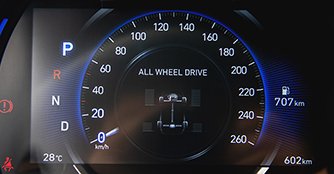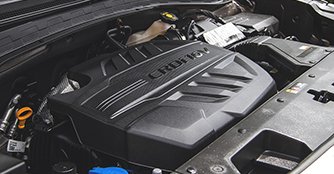Hyundai Santa Fe 2.2 R CRDi GLS (A) First Drive Review
06 Sep 2018|11,182 views
What We Like
Handsome styling
Spacious and well-equipped
Usable third row of seats
Diesel power plant is surprisingly refined
Comfortable and easy to drive
What We Dislike
Steering still rather vague
Lacklustre gearbox
SUVs are all the rage these days, with manufacturers pumping out all kinds of SUVs. 'Sporty', 'performance-oriented', 'chic', 'heroic dynamism', these are all adjectives we've seen on the marketing materials before.
But look past all that and at the core of an SUV's appeal is its ability to cover all the necessary bases - comfort, practicality and space for the entire family. This is a family car, after all.
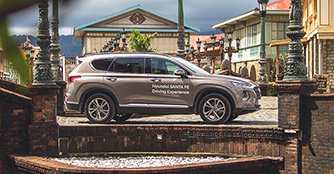
 The all new fourth generation Hyundai Santa Fe's new design certainly sets it apart from other seven-seater SUVs
The all new fourth generation Hyundai Santa Fe's new design certainly sets it apart from other seven-seater SUVs
In many ways, the Hyundai Santa Fe is a much more traditional or typical SUV, offering seven seats, generous family-oriented features and, well, a generally uninteresting drive. It's supposed to get people places, and that's what it does. But now, there's an all new one - the fourth generation Hyundai Santa Fe. How does it fare?
Un-bland
The first thing you will notice about the new Santa Fe is that it looks hella good. The handsome styling clearly draws inspiration from the Kona, with its Composite Light design and the brand's signature Cascading Grille making the front end look sharp and aggressive.
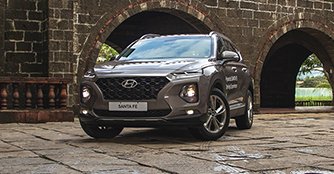
 The Santa Fe's sharp new look is most emphasised at the front, with the Cascading Grille nad Composite Light design
The Santa Fe's sharp new look is most emphasised at the front, with the Cascading Grille nad Composite Light design
Move past the front end and the good looks continue. A bold side character line runs across the body, emphasising the car's muscular presence.
All in all, the Santa Fe looks like an upsized Kona and that's a good thing because the Kona is certainly a sharp and good-looking vehicle. If nothing else, the new Santa Fe certainly looks more interesting than you'd expect from a seven-seating family SUV.
Comfort is in the details
The new Santa Fe is notably bigger all around than its predecessor. Here are some key numbers - 70mm longer, 10mm wider, 65mm longer wheelbase, additional 4mm first row legroom, additional 38mm second row legroom, and additional 23mm third row headroom.
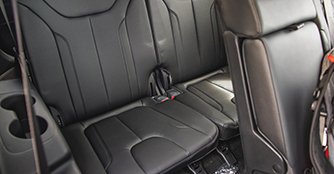
 Slide the second row forward and adults should be able to sit in the third row without feeling claustrophobic
Slide the second row forward and adults should be able to sit in the third row without feeling claustrophobic
Basically, the Santa Fe is more spacious than before. The cabin feels roomy and spacious, aided by the large sunroof letting light in from up top. There's increased legroom all around, and we reckon the third row can comfortably fit anyone 16 and below.
The Santa Fe also comprehensively covers your practicality needs. There are lots of cubby holes for storage, boot space with the third row folded has been increased by 31 litres to 547 litres, there are air-con vents for both the second and third row (with dedicated air-con controls for third row passengers), as well as four USB ports (two in the second row) so everyone gets to charge their smartphones concurrently.
The car also has good levels of equipment. Our full-specification test car came with a 7.0-inch touchscreen display with Apple CarPlay and Android Auto, a Qi wireless charger, head-up display, front power seats with driver memory seat, and a rear-view camera with dynamic guidelines. It's a generous list for sure.
Of course, a family SUV also needs to keep its occupants safe, and the Santa Fe features a slew of safety feature to do so, as part of Hyundai's SmartSense package. Notable is the industry-first Rear Occupant Alert, which uses ultrasonic sensors to monitor the rear seats and alerts the driver that there are still passengers there when leaving the car.
The Santa Fe also features Safety Exit Assist, which detects approaching traffic and warns the driver when the door is being opened. Additional safety systems include Rear Cross-Traffic Collision-Avoidance Assist, Blind-Spot Collision Warning and the Surround View Monitor System.
Motivation
Among the variety of powertrain choices offered with the new Santa Fe is this one - a 2.2-litre turbodiesel engine producing 197bhp and 441Nm of torque, paired to an eight-speed automatic gearbox.
But look past all that and at the core of an SUV's appeal is its ability to cover all the necessary bases - comfort, practicality and space for the entire family. This is a family car, after all.

In many ways, the Hyundai Santa Fe is a much more traditional or typical SUV, offering seven seats, generous family-oriented features and, well, a generally uninteresting drive. It's supposed to get people places, and that's what it does. But now, there's an all new one - the fourth generation Hyundai Santa Fe. How does it fare?
Un-bland
The first thing you will notice about the new Santa Fe is that it looks hella good. The handsome styling clearly draws inspiration from the Kona, with its Composite Light design and the brand's signature Cascading Grille making the front end look sharp and aggressive.

Move past the front end and the good looks continue. A bold side character line runs across the body, emphasising the car's muscular presence.
All in all, the Santa Fe looks like an upsized Kona and that's a good thing because the Kona is certainly a sharp and good-looking vehicle. If nothing else, the new Santa Fe certainly looks more interesting than you'd expect from a seven-seating family SUV.
Comfort is in the details
The new Santa Fe is notably bigger all around than its predecessor. Here are some key numbers - 70mm longer, 10mm wider, 65mm longer wheelbase, additional 4mm first row legroom, additional 38mm second row legroom, and additional 23mm third row headroom.

Basically, the Santa Fe is more spacious than before. The cabin feels roomy and spacious, aided by the large sunroof letting light in from up top. There's increased legroom all around, and we reckon the third row can comfortably fit anyone 16 and below.
The Santa Fe also comprehensively covers your practicality needs. There are lots of cubby holes for storage, boot space with the third row folded has been increased by 31 litres to 547 litres, there are air-con vents for both the second and third row (with dedicated air-con controls for third row passengers), as well as four USB ports (two in the second row) so everyone gets to charge their smartphones concurrently.
The car also has good levels of equipment. Our full-specification test car came with a 7.0-inch touchscreen display with Apple CarPlay and Android Auto, a Qi wireless charger, head-up display, front power seats with driver memory seat, and a rear-view camera with dynamic guidelines. It's a generous list for sure.
Of course, a family SUV also needs to keep its occupants safe, and the Santa Fe features a slew of safety feature to do so, as part of Hyundai's SmartSense package. Notable is the industry-first Rear Occupant Alert, which uses ultrasonic sensors to monitor the rear seats and alerts the driver that there are still passengers there when leaving the car.
The Santa Fe also features Safety Exit Assist, which detects approaching traffic and warns the driver when the door is being opened. Additional safety systems include Rear Cross-Traffic Collision-Avoidance Assist, Blind-Spot Collision Warning and the Surround View Monitor System.
Motivation
Among the variety of powertrain choices offered with the new Santa Fe is this one - a 2.2-litre turbodiesel engine producing 197bhp and 441Nm of torque, paired to an eight-speed automatic gearbox.
Power is sent to all four wheels via what Hyundai dubs 'HTRAC', its All-Wheel Drive (AWD) technology. HTRAC features variable torque control - up to 35% of torque can be sent to the rear wheels in comfort mode, with that figure going up to 50% in sport mode.
The engine is surprisingly refined when driven lightly. It's quiet and smooth, with generous amounts of torque to haul along the hefty Santa Fe.
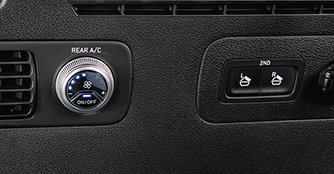
 Third row passengers have their own dedicated air-con controls, while the second row seats can be easily folded at a push of a button
Third row passengers have their own dedicated air-con controls, while the second row seats can be easily folded at a push of a button
Push it a little harder and the lack of top-end power shows, but this will likely be irrelevant to most buyers of this car. What you want (and need) for a car this size is low-end grunt, and the diesel engine is definitely a suitable choice.
As far as the ride goes, it's comfortable and well sorted, with significant improvement from before. The stiffer chassis and retuned suspension allows the car to be more composed, alleviating some of the more boat-like bounciness of the previous model.
Even on the poorly paved roads in the Philippines, the Santa Fe coped well, often dealing with potholes reasonably enough. Noise insulation is also pretty good, judging by how easy passengers seemed to fall asleep in the car during our test drive.
Handling is improved and slightly sharper compared to its predecessor, but still falls on the vague end of the scale. And there is some body roll entirely expected for a car this size. Does having AWD improve handling? Marginally, we'd imagine, but we can't say we felt the difference.
After all, the HTRAC system sends most of the power to the front wheels most of the time, so it drives largely like a front-wheel drive vehicle in most instances. The only time you can feel the extra traction the AWD system delivers is when powering out hard from a tight corner.
The main concern we have is the gearbox, which is slightly dim-witted. This isn't much of an issue when driving on highways, but aggressive driving is certainly discouraged. We drove up a section of windy mountain roads and the gearbox was unwilling and slow to downshift in manual mode, even when we flipped the paddle shifters furiously. Better, then, to just leave it in auto and let it do its job.
The engine is surprisingly refined when driven lightly. It's quiet and smooth, with generous amounts of torque to haul along the hefty Santa Fe.

Push it a little harder and the lack of top-end power shows, but this will likely be irrelevant to most buyers of this car. What you want (and need) for a car this size is low-end grunt, and the diesel engine is definitely a suitable choice.
As far as the ride goes, it's comfortable and well sorted, with significant improvement from before. The stiffer chassis and retuned suspension allows the car to be more composed, alleviating some of the more boat-like bounciness of the previous model.
Even on the poorly paved roads in the Philippines, the Santa Fe coped well, often dealing with potholes reasonably enough. Noise insulation is also pretty good, judging by how easy passengers seemed to fall asleep in the car during our test drive.
Handling is improved and slightly sharper compared to its predecessor, but still falls on the vague end of the scale. And there is some body roll entirely expected for a car this size. Does having AWD improve handling? Marginally, we'd imagine, but we can't say we felt the difference.
After all, the HTRAC system sends most of the power to the front wheels most of the time, so it drives largely like a front-wheel drive vehicle in most instances. The only time you can feel the extra traction the AWD system delivers is when powering out hard from a tight corner.
The main concern we have is the gearbox, which is slightly dim-witted. This isn't much of an issue when driving on highways, but aggressive driving is certainly discouraged. We drove up a section of windy mountain roads and the gearbox was unwilling and slow to downshift in manual mode, even when we flipped the paddle shifters furiously. Better, then, to just leave it in auto and let it do its job.
Finding its strength
Climbing up and down windy mountain roads ultimately isn't the Santa Fe's strong suit, though it certainly has the capability to do so. Instead, the car's greatest strength is being able to ferry seven people around in comfort and serenity, and in this regard the Santa Fe is commendably accomplished.
The new Santa Fe is undoubtedly much improved from its predecessor. Where it really excels is in providing a comfortable and safe space for the family, with generous cabin and safety equipment to please and protect all seven passengers inside the car. That the car is more comfortable and notably better to drive than before is a welcome bonus.
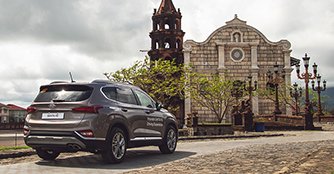
So, while the Santa Fe may not have the pomp and aplomb some other SUVs may have ('sports-car handling', 'harmonious perfection' and all that mambo jambo), what it has is a very clear and distinct understanding of its function and personality.
Over four generations, it's been continually refined and strengthened to make it stronger, better and more complete than before, so as to better fulfil its job of bringing a family around in comfort and safety. With this new Santa Fe, it is clearly a job well done.
What We Like
Handsome styling
Spacious and well-equipped
Usable third row of seats
Diesel power plant is surprisingly refined
Comfortable and easy to drive
What We Dislike
Steering still rather vague
Lacklustre gearbox
SUVs are all the rage these days, with manufacturers pumping out all kinds of SUVs. 'Sporty', 'performance-oriented', 'chic', 'heroic dynamism', these are all adjectives we've seen on the marketing materials before.
But look past all that and at the core of an SUV's appeal is its ability to cover all the necessary bases - comfort, practicality and space for the entire family. This is a family car, after all.

 The all new fourth generation Hyundai Santa Fe's new design certainly sets it apart from other seven-seater SUVsIn many ways, the Hyundai Santa Fe is a much more traditional or typical SUV, offering seven seats, generous family-oriented features and, well, a generally uninteresting drive. It's supposed to get people places, and that's what it does. But now, there's an all new one - the fourth generation Hyundai Santa Fe. How does it fare?
The all new fourth generation Hyundai Santa Fe's new design certainly sets it apart from other seven-seater SUVsIn many ways, the Hyundai Santa Fe is a much more traditional or typical SUV, offering seven seats, generous family-oriented features and, well, a generally uninteresting drive. It's supposed to get people places, and that's what it does. But now, there's an all new one - the fourth generation Hyundai Santa Fe. How does it fare?
Un-bland
The first thing you will notice about the new Santa Fe is that it looks hella good. The handsome styling clearly draws inspiration from the Kona, with its Composite Light design and the brand's signature Cascading Grille making the front end look sharp and aggressive.

 The Santa Fe's sharp new look is most emphasised at the front, with the Cascading Grille nad Composite Light designMove past the front end and the good looks continue. A bold side character line runs across the body, emphasising the car's muscular presence.
The Santa Fe's sharp new look is most emphasised at the front, with the Cascading Grille nad Composite Light designMove past the front end and the good looks continue. A bold side character line runs across the body, emphasising the car's muscular presence.
All in all, the Santa Fe looks like an upsized Kona and that's a good thing because the Kona is certainly a sharp and good-looking vehicle. If nothing else, the new Santa Fe certainly looks more interesting than you'd expect from a seven-seating family SUV.
Comfort is in the details
The new Santa Fe is notably bigger all around than its predecessor. Here are some key numbers - 70mm longer, 10mm wider, 65mm longer wheelbase, additional 4mm first row legroom, additional 38mm second row legroom, and additional 23mm third row headroom.

 Slide the second row forward and adults should be able to sit in the third row without feeling claustrophobicBasically, the Santa Fe is more spacious than before. The cabin feels roomy and spacious, aided by the large sunroof letting light in from up top. There's increased legroom all around, and we reckon the third row can comfortably fit anyone 16 and below.
Slide the second row forward and adults should be able to sit in the third row without feeling claustrophobicBasically, the Santa Fe is more spacious than before. The cabin feels roomy and spacious, aided by the large sunroof letting light in from up top. There's increased legroom all around, and we reckon the third row can comfortably fit anyone 16 and below.
The Santa Fe also comprehensively covers your practicality needs. There are lots of cubby holes for storage, boot space with the third row folded has been increased by 31 litres to 547 litres, there are air-con vents for both the second and third row (with dedicated air-con controls for third row passengers), as well as four USB ports (two in the second row) so everyone gets to charge their smartphones concurrently.
The car also has good levels of equipment. Our full-specification test car came with a 7.0-inch touchscreen display with Apple CarPlay and Android Auto, a Qi wireless charger, head-up display, front power seats with driver memory seat, and a rear-view camera with dynamic guidelines. It's a generous list for sure.
Of course, a family SUV also needs to keep its occupants safe, and the Santa Fe features a slew of safety feature to do so, as part of Hyundai's SmartSense package. Notable is the industry-first Rear Occupant Alert, which uses ultrasonic sensors to monitor the rear seats and alerts the driver that there are still passengers there when leaving the car.
The Santa Fe also features Safety Exit Assist, which detects approaching traffic and warns the driver when the door is being opened. Additional safety systems include Rear Cross-Traffic Collision-Avoidance Assist, Blind-Spot Collision Warning and the Surround View Monitor System.
Motivation
Among the variety of powertrain choices offered with the new Santa Fe is this one - a 2.2-litre turbodiesel engine producing 197bhp and 441Nm of torque, paired to an eight-speed automatic gearbox.
But look past all that and at the core of an SUV's appeal is its ability to cover all the necessary bases - comfort, practicality and space for the entire family. This is a family car, after all.

Un-bland
The first thing you will notice about the new Santa Fe is that it looks hella good. The handsome styling clearly draws inspiration from the Kona, with its Composite Light design and the brand's signature Cascading Grille making the front end look sharp and aggressive.

All in all, the Santa Fe looks like an upsized Kona and that's a good thing because the Kona is certainly a sharp and good-looking vehicle. If nothing else, the new Santa Fe certainly looks more interesting than you'd expect from a seven-seating family SUV.
Comfort is in the details
The new Santa Fe is notably bigger all around than its predecessor. Here are some key numbers - 70mm longer, 10mm wider, 65mm longer wheelbase, additional 4mm first row legroom, additional 38mm second row legroom, and additional 23mm third row headroom.

The Santa Fe also comprehensively covers your practicality needs. There are lots of cubby holes for storage, boot space with the third row folded has been increased by 31 litres to 547 litres, there are air-con vents for both the second and third row (with dedicated air-con controls for third row passengers), as well as four USB ports (two in the second row) so everyone gets to charge their smartphones concurrently.
The car also has good levels of equipment. Our full-specification test car came with a 7.0-inch touchscreen display with Apple CarPlay and Android Auto, a Qi wireless charger, head-up display, front power seats with driver memory seat, and a rear-view camera with dynamic guidelines. It's a generous list for sure.
Of course, a family SUV also needs to keep its occupants safe, and the Santa Fe features a slew of safety feature to do so, as part of Hyundai's SmartSense package. Notable is the industry-first Rear Occupant Alert, which uses ultrasonic sensors to monitor the rear seats and alerts the driver that there are still passengers there when leaving the car.
The Santa Fe also features Safety Exit Assist, which detects approaching traffic and warns the driver when the door is being opened. Additional safety systems include Rear Cross-Traffic Collision-Avoidance Assist, Blind-Spot Collision Warning and the Surround View Monitor System.
Motivation
Among the variety of powertrain choices offered with the new Santa Fe is this one - a 2.2-litre turbodiesel engine producing 197bhp and 441Nm of torque, paired to an eight-speed automatic gearbox.
Power is sent to all four wheels via what Hyundai dubs 'HTRAC', its All-Wheel Drive (AWD) technology. HTRAC features variable torque control - up to 35% of torque can be sent to the rear wheels in comfort mode, with that figure going up to 50% in sport mode.
The engine is surprisingly refined when driven lightly. It's quiet and smooth, with generous amounts of torque to haul along the hefty Santa Fe.

 Third row passengers have their own dedicated air-con controls, while the second row seats can be easily folded at a push of a buttonPush it a little harder and the lack of top-end power shows, but this will likely be irrelevant to most buyers of this car. What you want (and need) for a car this size is low-end grunt, and the diesel engine is definitely a suitable choice.
Third row passengers have their own dedicated air-con controls, while the second row seats can be easily folded at a push of a buttonPush it a little harder and the lack of top-end power shows, but this will likely be irrelevant to most buyers of this car. What you want (and need) for a car this size is low-end grunt, and the diesel engine is definitely a suitable choice.
As far as the ride goes, it's comfortable and well sorted, with significant improvement from before. The stiffer chassis and retuned suspension allows the car to be more composed, alleviating some of the more boat-like bounciness of the previous model.
Even on the poorly paved roads in the Philippines, the Santa Fe coped well, often dealing with potholes reasonably enough. Noise insulation is also pretty good, judging by how easy passengers seemed to fall asleep in the car during our test drive.
Handling is improved and slightly sharper compared to its predecessor, but still falls on the vague end of the scale. And there is some body roll entirely expected for a car this size. Does having AWD improve handling? Marginally, we'd imagine, but we can't say we felt the difference.
After all, the HTRAC system sends most of the power to the front wheels most of the time, so it drives largely like a front-wheel drive vehicle in most instances. The only time you can feel the extra traction the AWD system delivers is when powering out hard from a tight corner.
The main concern we have is the gearbox, which is slightly dim-witted. This isn't much of an issue when driving on highways, but aggressive driving is certainly discouraged. We drove up a section of windy mountain roads and the gearbox was unwilling and slow to downshift in manual mode, even when we flipped the paddle shifters furiously. Better, then, to just leave it in auto and let it do its job.
The engine is surprisingly refined when driven lightly. It's quiet and smooth, with generous amounts of torque to haul along the hefty Santa Fe.

As far as the ride goes, it's comfortable and well sorted, with significant improvement from before. The stiffer chassis and retuned suspension allows the car to be more composed, alleviating some of the more boat-like bounciness of the previous model.
Even on the poorly paved roads in the Philippines, the Santa Fe coped well, often dealing with potholes reasonably enough. Noise insulation is also pretty good, judging by how easy passengers seemed to fall asleep in the car during our test drive.
Handling is improved and slightly sharper compared to its predecessor, but still falls on the vague end of the scale. And there is some body roll entirely expected for a car this size. Does having AWD improve handling? Marginally, we'd imagine, but we can't say we felt the difference.
After all, the HTRAC system sends most of the power to the front wheels most of the time, so it drives largely like a front-wheel drive vehicle in most instances. The only time you can feel the extra traction the AWD system delivers is when powering out hard from a tight corner.
The main concern we have is the gearbox, which is slightly dim-witted. This isn't much of an issue when driving on highways, but aggressive driving is certainly discouraged. We drove up a section of windy mountain roads and the gearbox was unwilling and slow to downshift in manual mode, even when we flipped the paddle shifters furiously. Better, then, to just leave it in auto and let it do its job.
Finding its strength
Climbing up and down windy mountain roads ultimately isn't the Santa Fe's strong suit, though it certainly has the capability to do so. Instead, the car's greatest strength is being able to ferry seven people around in comfort and serenity, and in this regard the Santa Fe is commendably accomplished.
The new Santa Fe is undoubtedly much improved from its predecessor. Where it really excels is in providing a comfortable and safe space for the family, with generous cabin and safety equipment to please and protect all seven passengers inside the car. That the car is more comfortable and notably better to drive than before is a welcome bonus.

 The fourth generation Santa Fe is notably improved, with sharper looks, better equipment, added safety and a more refined overall experienceSo, while the Santa Fe may not have the pomp and aplomb some other SUVs may have ('sports-car handling', 'harmonious perfection' and all that mambo jambo), what it has is a very clear and distinct understanding of its function and personality.
The fourth generation Santa Fe is notably improved, with sharper looks, better equipment, added safety and a more refined overall experienceSo, while the Santa Fe may not have the pomp and aplomb some other SUVs may have ('sports-car handling', 'harmonious perfection' and all that mambo jambo), what it has is a very clear and distinct understanding of its function and personality.
Over four generations, it's been continually refined and strengthened to make it stronger, better and more complete than before, so as to better fulfil its job of bringing a family around in comfort and safety. With this new Santa Fe, it is clearly a job well done.
Climbing up and down windy mountain roads ultimately isn't the Santa Fe's strong suit, though it certainly has the capability to do so. Instead, the car's greatest strength is being able to ferry seven people around in comfort and serenity, and in this regard the Santa Fe is commendably accomplished.
The new Santa Fe is undoubtedly much improved from its predecessor. Where it really excels is in providing a comfortable and safe space for the family, with generous cabin and safety equipment to please and protect all seven passengers inside the car. That the car is more comfortable and notably better to drive than before is a welcome bonus.

Over four generations, it's been continually refined and strengthened to make it stronger, better and more complete than before, so as to better fulfil its job of bringing a family around in comfort and safety. With this new Santa Fe, it is clearly a job well done.
Thank You For Your Subscription.


































